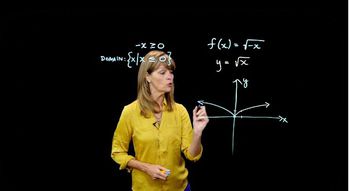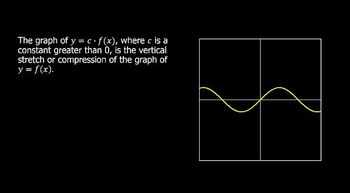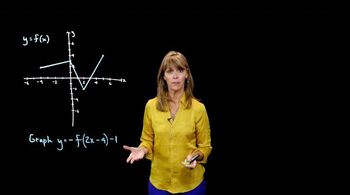Table of contents
- 0. Review of Algebra4h 16m
- 1. Equations & Inequalities3h 18m
- 2. Graphs of Equations43m
- 3. Functions2h 17m
- 4. Polynomial Functions1h 44m
- 5. Rational Functions1h 23m
- 6. Exponential & Logarithmic Functions2h 28m
- 7. Systems of Equations & Matrices4h 6m
- 8. Conic Sections2h 23m
- 9. Sequences, Series, & Induction1h 19m
- 10. Combinatorics & Probability1h 45m
3. Functions
Transformations
Problem 94
Textbook Question
In Exercises 81–94, begin by graphing the absolute value function, f(x) = |x|. Then use transformations of this graph to graph the given function. g(x) = -2|x+3|+2
 Verified step by step guidance
Verified step by step guidance1
Start by graphing the basic absolute value function, \( f(x) = |x| \). This graph is a V-shaped graph with its vertex at the origin (0,0) and opens upwards.
Identify the transformations needed to graph \( g(x) = -2|x+3|+2 \) based on the basic graph of \( f(x) = |x| \).
Apply a horizontal shift to the graph of \( f(x) = |x| \) by moving it 3 units to the left. This is due to the \( x+3 \) inside the absolute value, resulting in \( |x+3| \).
Apply a vertical stretch and reflection. The coefficient \(-2\) indicates a vertical stretch by a factor of 2 and a reflection over the x-axis. This changes the graph to open downwards.
Finally, apply a vertical shift by moving the graph 2 units up. This is due to the \(+2\) outside the absolute value, resulting in the final graph of \( g(x) = -2|x+3|+2 \).
 Verified video answer for a similar problem:
Verified video answer for a similar problem:This video solution was recommended by our tutors as helpful for the problem above
Video duration:
6mPlay a video:
Was this helpful?
Key Concepts
Here are the essential concepts you must grasp in order to answer the question correctly.
Absolute Value Function
The absolute value function, denoted as f(x) = |x|, outputs the non-negative value of x. This function has a V-shaped graph that opens upwards, with its vertex at the origin (0,0). Understanding this function is crucial as it serves as the foundation for applying transformations to graph other functions.
Recommended video:

Function Composition
Transformations of Functions
Transformations involve shifting, reflecting, stretching, or compressing the graph of a function. For example, adding a constant inside the absolute value affects horizontal shifts, while adding outside affects vertical shifts. In the function g(x) = -2|x+3|+2, the transformations include a horizontal shift left by 3 units, a vertical stretch by a factor of 2, and a reflection across the x-axis.
Recommended video:

Domain & Range of Transformed Functions
Graphing Techniques
Graphing techniques involve plotting points and understanding how transformations affect the shape and position of a graph. For the function g(x), one must first graph f(x) = |x|, then apply the identified transformations systematically. This process helps visualize how the original graph is altered, leading to an accurate representation of the new function.
Recommended video:
Guided course

Graphs and Coordinates - Example

 5:25m
5:25mWatch next
Master Intro to Transformations with a bite sized video explanation from Nick Kaneko
Start learningRelated Videos
Related Practice

























